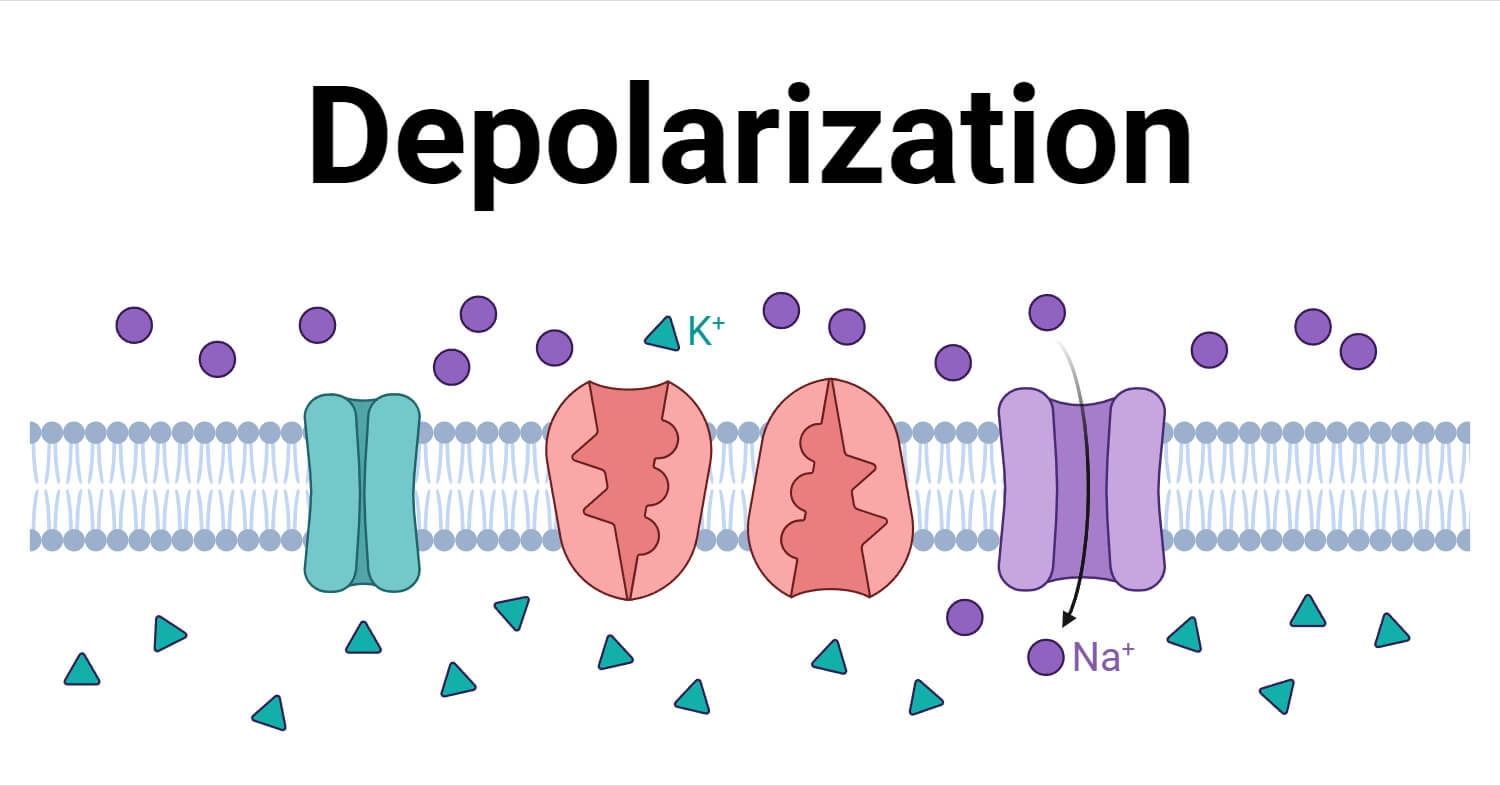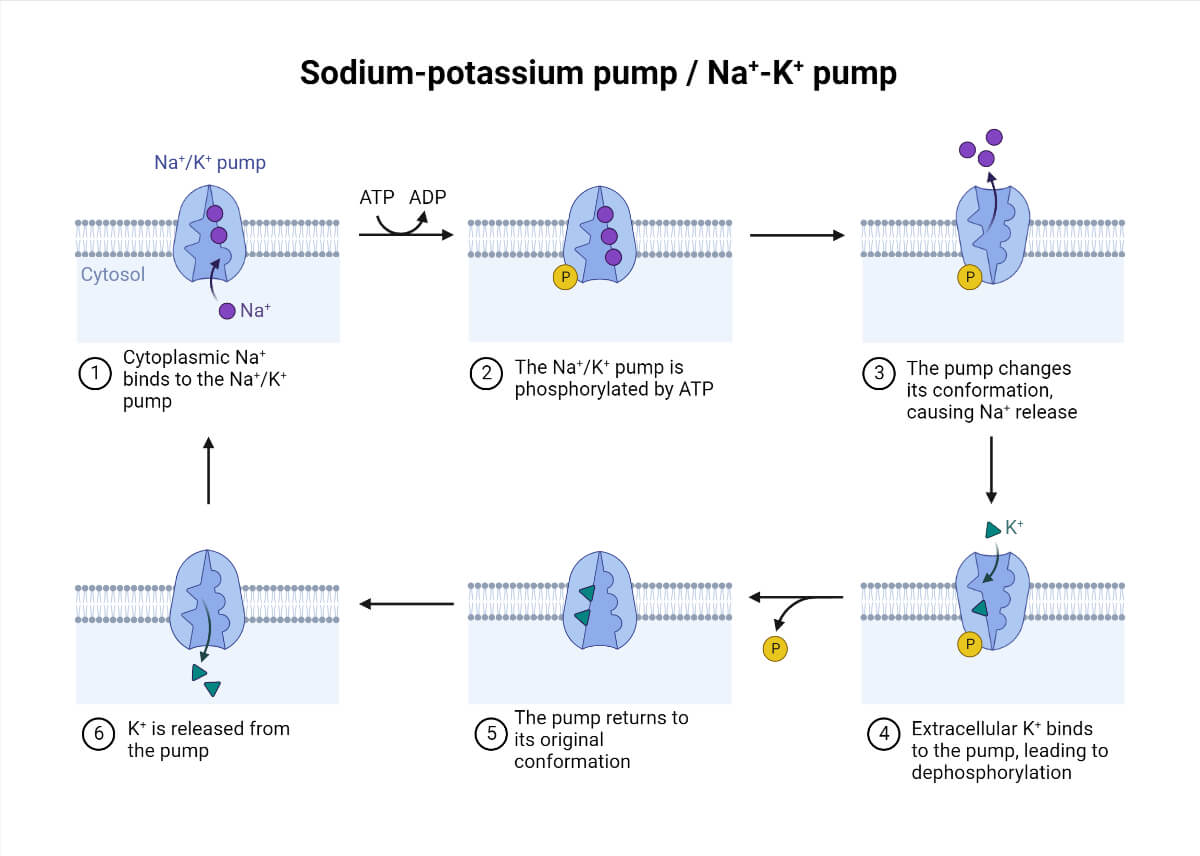Cell-cell communication is a crucial part of biological systems. Among various ways of cell communication, communication through electrical signals is of great significance where depolarization plays an important role in transmitting the impulse.
Neuronal stimulation can be caused by chemical messengers such as neurotransmitters or environmental changes such as pressure, sound, and light. It causes different ion channels to open, through which positively charged ions like sodium or potassium can enter the cell, decreasing the negative charge inside the cell, a phenomenon called depolarization.
Depolarization is the cellular event characterized by the shift in the distribution of electric charges within a cell, particularly evident in cell membranes, majorly neural membranes for the conduction of impulses.

This process leads to a reduction in the negative charge inside the cell relative to its external environment, for the propagation of electric signals essential for intercellular communication. It occurs for only a short period.
Interesting Science Videos
Excitable cells
- Excitable cells are those that are responsive to electrical stimulation.
- These cells possess specialized ion channels embedded within their plasma membranes, facilitating the regulated movement of ions across the membrane barrier.
- These movement of ions across the channels is in response to different electrical stimulation. When these excitable cells encounter stimulus, they permit the influx and efflux of ions.
- This dynamic movement initiates changes in the membrane potential altering its relative charge about the extracellular environment.
Excitable cells include diverse cell types
Neurons cells
These neuron cells through depolarization propagate nerve impulses along the axons facilitating communication within the cells.
Muscle cells
Similarly, muscle cells possess the property of excitability allowing for the coordinated contraction of muscles for movement and locomotion.
Cardiomyocytes (Cardiac cells)
Also, excitable cells include specialized cells such as cardiomyocytes in the heart which regulate cardiac rhythm.
Endocrine cells
Endocrine cells in glandular tissues are responsible for hormone secretion which is brought by the depolarization of these cells.
Other various excitable cells are present in the body for the conduction of electrical stimulation.
Electrochemical gradients
- These gradients arise from differences in ion concentration between the intracellular and extracellular environments, achieved due to the selective permeability of the cell membranes to specific ions.
- In excitable such as neurons, the predominant ions involved in generating electrochemical gradient are sodium (Na+) and potassium (K+).
- Under resting conditions, the cell membrane exhibits a negative resting potential, primarily due to a higher concentration of positively charged ions outside the cell. The differences in charge are maintained by the sodium-potassium pumps, which utilize ATP to transport ions against their concentration gradient.
Graded potential
- They represent the localized changes in membrane potential resulting from the alterations in the flow of ions across the cell membrane.
- When a stimulus binds to the receptor, it brings changes in the distribution of charges across the membrane causing either depolarization (reduced negativity) or hyperpolarization (increased negativity).
Resting membrane potential
- Neurons at rest maintain a resting membrane potential at -70mv, established by a balance of ion movement across the cell membrane.
- Resting membrane potential arises from the unequal distribution of sodium and potassium ions maintained by sodium and potassium pumps.
- Both sodium and potassium ions continually move across the membrane, driven by their respective concentration gradients and membrane potential.
- The membrane is more permeable to potassium ions than sodium ions due to the higher number of open potassium channels.
- Initially, potassium ions move out of cells, while sodium ions move into the cell, resulting in net outward movement of positive charge, contributing to a negative membrane potential.
- As the membrane potential becomes more negative, potassium movements slow down and sodium movements accelerate, eventually reaching equilibrium where no net movement of charge occurs. It is established by pumping three positively charged sodium ions (3Na+) out of the cell for every two positively charged potassium ions(2K+) inside.
- The final resting membrane potential of approximately -70mV is closer to the potassium equilibrium potential due to the higher permeability of the membrane to potassium ions. Continuous ATP-dependent activity of Na+ and K+ pump maintains the required environment.
Depolarization
- A cell undergoes depolarization after reaching its resting potential and when it senses any stimulus.
- Membrane potential shifts quickly from negative to positive during depolarization.
- Voltage-gated sodium channels and voltage-gated calcium channels which were closed during resting potential, open in response to an initial shift in membrane voltage. The sodium-potassium pump continues to function during depolarization.
- The membrane potential changes from negative to positive as sodium ions rush back into the cell, adding a positive charge and altering the interior change.
- Depolarization is complete when the interior of the cell becomes more positively charged, at which point the channels close once again.
- Depolarization happens when the sodium channels open. Since there is more sodium on the outside of the cell, as mentioned above, that positive sodium starts to make its way into the cell once those channels open.
- This leads to the inside of the cell becoming more positive. Therefore, it is depolarizing because there is less of a difference between the inside and the outside of a cell.
Action Potential

- An action potential is initiated by a depolarization event, resulting from the simultaneous occurrence of multiple depolarizing inputs.
- Action potential commences when a depolarization surpasses the threshold value, typically around -55 millivolts.
- Upon reaching the threshold, voltage-gated sodium (Na+) channels embedded in the membrane rapidly open, allowing a large influx of sodium ions into the cell, causing a rapid increase in the membrane potential, known as the rising phase.
- Following sodium channel inactivation, voltage-gated channel potassium(K+) channels open, enabling potassium ions to exit the cell, driving the membrane potential back toward its resting state, a phase termed repolarization.
- The prolonged opening of potassium channels may lead to an undershot, where the membrane potential briefly dips below its resting potential before stabilizing.
- Subsequently, voltage-gated potassium channels lose, and the membrane potential returns to its resting state, while sodium channels reset to their closed, but responsive state, preparing for subsequent action potentials.

To summarize (majorly in neuron cells)
In the context of neuron physiology, depolarization is crucial for nerve impulse transmission. The electrochemical gradient across the cell membrane, predominantly influenced by sodium ions and potassium ions, establishes a resting membrane potential, typically around -70mV. When the cell is stimulated and reaches the threshold voltage (approximately -55mV), voltage-gated sodium ion channels open, allowing an influx of positive charge sodium ions into the cell. This influx of positive charge triggers depolarization, resulting in a less negative charge inside the cell.
Subsequently, the cell aims to return to its resting stage by repolarization. Potassium ions exit the cell, restoring the negative charge inside, while sodium-potassium pumps actively transport against their concentration gradients, re-establishing the resting membrane potential. This cyclic process of depolarization and repolarization allows for the transmission of nerve impulses, facilitating vital functions within the organisms.
Difference between depolarization and repolarization
| Character | Depolarization | Repolarization |
| Definition | Movement of membrane potential to a comparatively positive value | Membrane potential value returns to its initial negative value |
| Membrane potential | The membrane potential increases; inner membrane becomes less negative | Membrane potential decreases restoring the membrane potential; the inner membrane becomes negative |
| Process | Positive ions flow into the cell | Positive ions flow out of the cell |
| Mechanism | Opening of Na+ and Ca++ channels for influx | Opening and efflux of potassium ions |
| Ions involved | Na+, Ca++ ions | K+ ion |
| Action in the neuron | Initiates action potential | Restores resting membrane potential |
| Action in the muscle | Initiates muscle contraction | Allows muscle relaxation |
References
- Depolarization. July 2022. Practical Psychology. Retrieved from https://practicalpie.com/depolarization/. Accessed on 28th April.
- Hall, J.E. and Hall, M.E. (2021). Guyton and Hall Textbook of Medical Physiology. 14th Edition. Elsevier.
- Neuron depolarization, hyperpolarization and action potential. Khan Academy. Retrieved from https://www.khanacademy.org/science/biology/human-biology/neuron-nervous-system/a/depolarization-hyperpolarization-and-action-potentials. Accessed on 5th April 2024.
- Silverthorn, D.U. (2019). Human Physiology: An integrated approach. 8th Edition. Pearson.
- Stanfield, C.L. (2017). Principles of Human Physiology. 6th Edition. Pearson.
- Williams, J. and Robb, A. (2023). Cell Depolarization/ Definition and Overview. Study.com Retrieved from https://study.com/academy/lesson/depolarization-definition-lesson-quiz.html. Accessed on 25th April 2024.

easy to understand